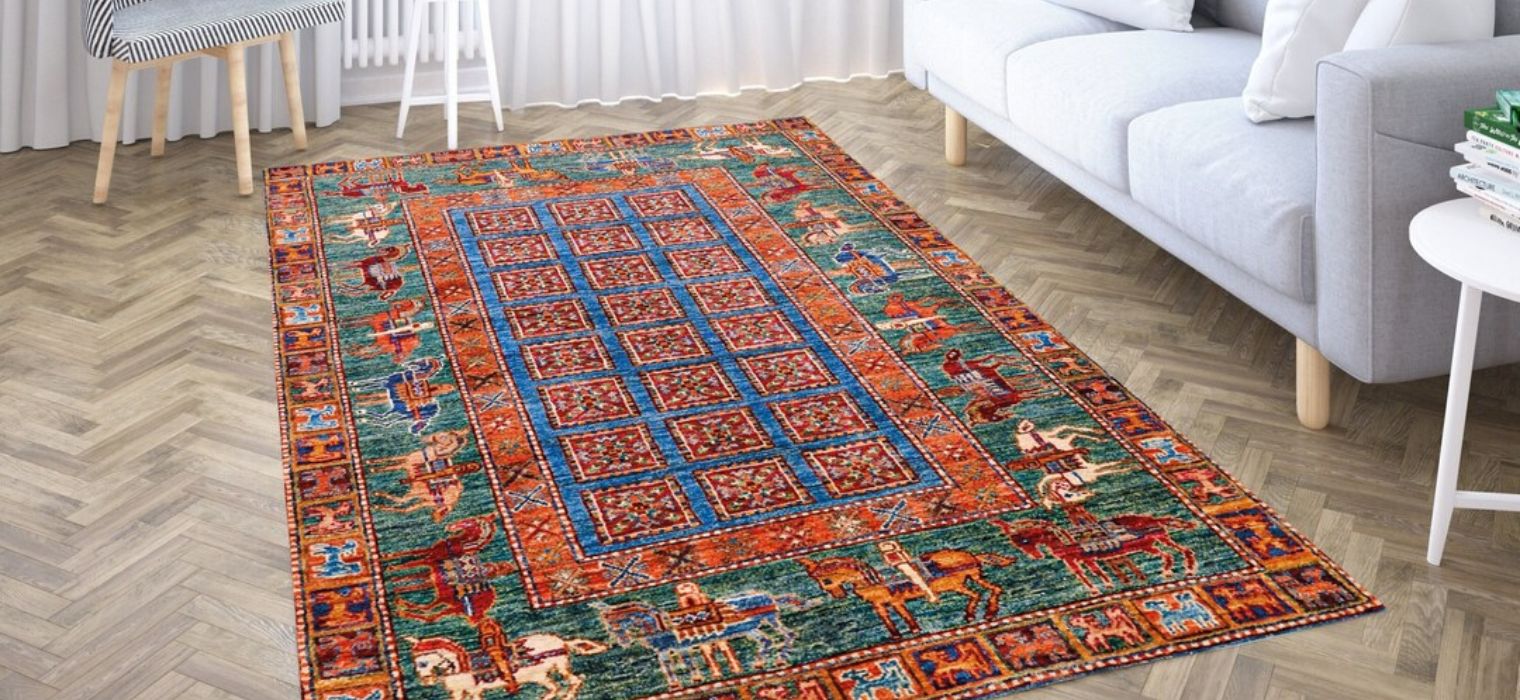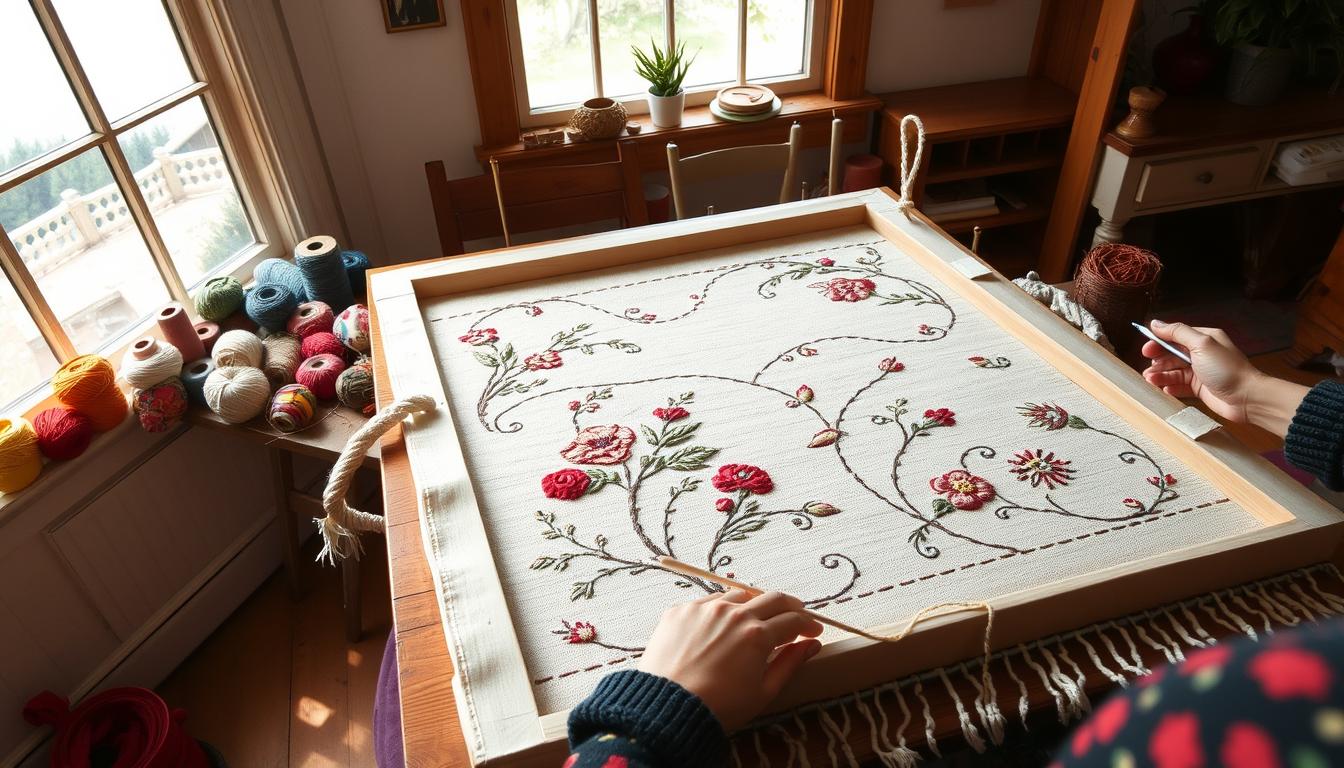
6 Key Facts About Hooked Rugs
Could a simple craft technique hold the secret to transforming your home’s character? For centuries, artisans have turned humble materials like wool strips and burlap into functional art through textile craftsmanship. This tactile tradition combines practicality with creative flair, resulting in pieces that elevate spaces while preserving heritage.

Unlike mass-produced floor coverings, these pieces showcase individuality. Their looped textures and vibrant patterns reveal the maker’s hand in every pull of the hook. Traditional methods use long fabric strips, while modern variations employ pre-cut yarn for quicker projects. Both approaches create durable, eye-catching decor.
You’ll uncover how this craft evolved from necessity to artistic expression. Early makers recycled worn clothing into floor protectors, blending resourcefulness with design. Today’s creators continue this legacy, choosing materials that balance aesthetics with longevity.
Key Takeaways
- Fabric strips or yarn form distinctive loops through specialized hooking techniques
- Traditional methods differ from latch hooking in materials and execution
- Durable foundation fabrics like linen ensure lasting quality
- Historical roots in repurposing materials influence modern designs
- Customizable patterns adapt to personal style preferences
- Combines practical flooring solutions with artistic decoration
Introduction and History of Hooked Rugs
The story of hooked rugs begins in the bustling mills of 19th-century England. Textile workers in Yorkshire gathered yarn scraps from factory floors, looping them through burlap to create early versions of these floor coverings. This thrifty practice crossed the Atlantic, finding fertile ground in New England’s resourceful households.
Origins and Evolution in England and America
By the 1830s, American families wanted affordable alternatives to pricey factory-made carpets. Hooking became a lifeline—transforming feed sacks and worn clothing into warm floor protectors. The craft flourished in coastal communities where sailors traded burlap grain bags, which became the standard backing material.
Despite its practicality, 19th-century society dismissed rug creation as “poor man’s art”. Ladies’ magazines ignored the technique while praising embroidery and quilting. Yet this dismissal fueled innovation, as makers developed regional styles using available dyes and fabrics.
Early Materials and Backing Techniques
Grain bags weren’t just packaging—they were craft essentials. Families washed and stretched the coarse fabric, then pulled wool strips through it with handmade hooks. Some used sailmaker’s tools, while others fashioned hooks from nails or umbrella ribs.
This resourcefulness shaped rug designs. Patterns often mirrored household needs—geometric shapes hid dirt better in high-traffic areas. What began as necessity became tradition, with techniques passed through generations until hooked pieces gained recognition as folk art.
What is a Hooked Rug: A Beginner's Guide
Transform fabric scraps into stunning decor with a simple technique. Unlike knotted floor coverings, these pieces use loops pulled through backing material. No complex ties—just consistent patterns that build texture and durability.

The magic lies in uncut loops. Each strand stays intact, creating raised surfaces that hide wear. Compare this to tufted rugs, where sheared fibers flatten over time. Your finished piece becomes both artwork and practical flooring.
Tools range from handheld hooks to mechanical aids. Beginners often start with basic kits containing a punch needle and linen backing. With practice, you’ll develop rhythm—pulling yarn upward, forming uniform heights for even surfaces.
| Feature | Hooked Rugs | Tufted Rugs |
|---|---|---|
| Surface Texture | Raised loops | Cut pile |
| Durability | High (uncut fibers) | Moderate |
| Common Use | Entryways, kitchens | Bedrooms, living rooms |
This craft adapts to your pace. Choose quick machine methods or slow handwork. Either approach yields sturdy results perfect for busy spaces. Ready to explore materials and patterns? Later sections break down wool types and design strategies.
Rug Hooking Techniques and Construction
Mastering fabric manipulation methods unlocks endless creative possibilities. Whether preserving tradition or exploring modern adaptations, these approaches blend practicality with artistic expression.
Exploring the Differences: Hooked vs. Latch Hooking
Traditional methods require pulling continuous fabric strips through backing material using specialized hooks. This technique creates dense, plush surfaces that withstand heavy foot traffic. Latch hooking simplifies the process through pre-cut yarn segments secured with basic knots.
| Feature | Traditional Hooking | Latch Hooking |
|---|---|---|
| Tool Type | Metal punch needle | Latch hook tool |
| Material Used | Fabric strips | Pre-cut yarn |
| Loop Style | Continuous uncut loops | Individual knotted strands |
| Skill Level | Intermediate | Beginner-friendly |
Step-by-Step Process for Crafting Your First Rug
Start with quality linen backing stretched tightly on a frame. Follow these construction essentials:
- Position fabric strips beneath the backing material
- Push hook through backing, catch material, pull upward
- Maintain even tension for uniform loop height
- Work row-by-row to prevent distortion
Practice hand coordination on scrap materials before tackling larger projects. Many crafters find rhythm develops naturally after completing 2-3 square feet. For ongoing maintenance tips, explore our proper cleaning methods to preserve your creation's beauty.
Exploring Materials and Tools for Rug Hooking
The foundation of every great hooked piece lies in two elements: quality materials and reliable tools. Your choices here determine both creative flexibility and long-term durability. Let’s break down modern options and their historical roots.

Choosing the Right Wool, Yarn, and Scrap Materials
Wool dominates modern projects for good reason. Worsted-weight varieties strike the perfect balance between sturdiness and pliability. Look for yarns labeled 3.5–4 stitches per inch—this thickness prevents gaps while allowing smooth hooking motions.
Many crafters mix new wool materials with recycled fabrics. Upcycled textiles add character and reduce costs. One maker’s scrap becomes another’s floral motif or geometric border.
Evolution of Tools: Efficiency Meets Ergonomics
Early artisans used repurposed nails or umbrella ribs as hooks. Danish inventor Ernst Thomsen changed the game in the 1930s with his spring-loaded tool. Marketed first as the Aladdin Carpet Needle, it evolved into the Danella Rug Hooking Tool—a staple in modern kits.
| Feature | Traditional Tools | Modern Tools |
|---|---|---|
| Tool Type | Handmade metal hooks | Ergonomic spring handles |
| Material Compatibility | Thick fabric strips | All yarn weights |
| Speed | 5 sq. ft/week | 12+ sq. ft/week |
| Ergonomics | High hand fatigue | Reduced strain |
Today’s tools let you work faster without sacrificing precision. Pair them with sustainable yarn options for eco-conscious creations. Your projects will reflect centuries of innovation—one loop at a time.
Practical Tips and Common Pitfalls in Rug Hooking
Creating durable textile projects requires attention to three critical factors: color stability, structural foundations, and material selection. Overlooking these elements can turn your creative effort into a short-lived piece.
Fiber Quality, Dye Testing, and Backing Considerations
Always test dyes before committing to materials. Rub a damp handkerchief on vibrant sections—if color transfers after drying, you’ve got “crocking” issues. This bleeding effect ruins designs during cleaning and compromises texture over time.
High-quality pieces don’t hide their construction. Flip them over—visible loops indicate proper technique without cheap latex additives. Avoid backings that release powdery residue when tapped; these adhesives crumble during washing.
Your foundation determines longevity. Tightly woven linen or burlap prevents stretching and maintains shape. Test it by gently pulling loops—secure anchors prevent unraveling from foot traffic or vacuuming.
- Check for stenciling marks in bright pink/blue—these bleed during cleaning
- Prioritize flexible pieces over stiff, latex-coated alternatives
- Use scrap materials for practice before major projects
These tips help you spot craftsmanship differences. Well-made creations balance aesthetics with practicality, honoring traditions while meeting modern durability standards.
American Hooked Rugs: Tradition and Trends
Resourcefulness stitched itself into national identity through fabric and burlap. New England households turned necessity into artistry when factory-made floor coverings outpriced budgets in the 1830s. This thrifty practice became a cultural staple, blending utility with self-expression across generations.
Cultural Significance and Historical Developments in the US
Coastal communities transformed grain sacks into canvases using wool scraps from worn clothing. Sailors traded burlap while women developed regional styles—nautical motifs in Maine, floral bursts in Pennsylvania. These creations warmed floors and preserved family histories through symbolic patterns.
By 1900, american hooked rugs appeared in urban catalogs, signaling broader acceptance. Craft schools emerged, teaching techniques once dismissed as "poor man's art." Museums now display early pieces as folk art treasures.
Design Patterns and Modern Interpretations
Today’s makers honor tradition while embracing bold geometry and abstract forms. Sustainable practices revive scrap fabric use—denim strips create textured blues, while vintage linens add heritage charm. Digital tools help convert photos into punch needle templates.
Contemporary american hooked designs thrive in minimalist interiors. Neutral palettes with metallic threads update classic motifs. Whether crafting heirlooms or statement pieces, this craft remains rooted in accessibility—proof that humble materials can shape enduring beauty.
FAQ
How did rug hooking develop in England and America?
Rug hooking began in 19th-century England as a thrifty craft using scraps of wool or yarn. Early American settlers adapted it with burlap backing and natural dyes, evolving into a distinct folk art form by the late 1800s.
What’s the difference between hooked and latch hook rugs?
Traditional hooked rugs use a handheld tool to pull loops of fabric through backing, creating dense texture. Latch hooking employs a specialized tool to knot short yarn strands, resulting in a shaggier surface ideal for bold designs.
Why is wool preferred for rug hooking projects?
Wool’s durability and natural elasticity make it perfect for maintaining loop structure. Brands like Berber Wool or Harrisville Designs offer colorfast yarns that withstand foot traffic while retaining vibrant hues over time.
How do Danella tools improve modern rug hooking?
Danella’s ergonomic hooks feature adjustable handles and precision tips for consistent loop heights. Their designs reduce hand fatigue, allowing crafters to work longer on intricate patterns without compromising control.
What backing materials work best for beginners?
Monk’s cloth or linen backing provides stability for new crafters. Avoid synthetic blends—they fray easily. For smaller projects like bags, burlap offers an affordable, rustic option that grips fibers securely.
Why test dyes before starting a hooked rug?
Some dyes bleed when washed or exposed to light. Pre-testing scraps prevents color transfer between sections. Use pH-neutral cleaners like Eucalan to preserve hand-dyed wool integrity during maintenance.
How did 20th-century America influence hooked rug designs?
The Arts and Crafts movement revived geometric patterns, while companies like Pearl McGown popularized stamped kits. Today, artists blend traditional motifs with abstract themes using gradient yarns from brands such as Ashford.
What’s the biggest mistake new rug hookers make?
Over-tightening loops causes warped backing and uneven texture. Maintain consistent tension using a hoop frame, and practice on swatches before tackling large-scale projects like floor rugs.









